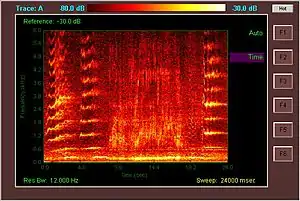List of whale vocalizations
Whale vocalizations are the sounds made by whales to communicate. The word "song" is used in particular to describe the pattern of regular and predictable sounds made by some species of whales (notably the humpback) in a way that is reminiscent of human singing.

Humans produce sound by expelling air through the larynx. The vocal cords within the larynx open and close as necessary to separate the stream of air into discrete pockets of air. These pockets are shaped by the throat, tongue, and lips into the desired sound.
Cetacean sound production differs markedly from this mechanism. The precise mechanism differs in the two major suborders of cetaceans: the Odontoceti (toothed whales—including dolphins) and the Mysticeti (baleen whales—including the largest whales, such as the blue whale).
Blue whale (Balaenoptera musculus)
Estimates made by Cummings and Thompson (1971)[1] and Richardson et al. (1995)[2] suggest that source level of sounds made by blue whales are between 155 and 188 decibels when measured at a reference pressure of one micropascal at one metre. All blue whale groups make calls at a fundamental frequency of between 10 and 40 Hz, and the lowest frequency sound a human can typically perceive is 20 Hz. Blue whale calls last between ten and thirty seconds. Additionally blue whales off the coast of Sri Lanka have been recorded repeatedly making "songs" of four notes duration lasting about two minutes each, reminiscent of the well-known humpback whale songs.
All of the baleen whale sound files on this page (with the exception of the humpback vocalizations) are reproduced at 10x speed to bring the sound into the human auditory band.
Fin whale (Balaenoptera physalus)
Like other whales, the male fin whale has been observed to make long, loud, low-frequency sounds.[3] Most sounds are frequency-modulated (FM) down-swept infrasonic pulses from 16 to 40 hertz frequency (the range of sounds that most humans can hear falls between 20 hertz and 20 kilohertz). Each sound lasts between one and two seconds, and various combinations of sounds occur in patterned sequences lasting 7 to 15 minutes each. These sequences are then repeated in bouts lasting up to many days.[4]
Humpback whale (Megaptera novaeangliae)
The humpback whale is well known for its long and complex song. Humpbacks repeat patterns of low notes that vary in amplitude and frequency in consistent patterns over a period of hours or even days. Only male humpbacks sing, so it was at first assumed that the songs were solely for courting. While the primary purpose of whale song may be to attract females, it is almost certain that whale song serves myriad purposes.
Orca (killer whale) (Orcinus orca)
As with other dolphins, orcas are very vocal animals. They produce a variety of clicks and whistles that are used for communication and echolocation. The vocalization types vary with activity. While resting they are much quieter, merely emitting an occasional call that is distinct from those heard when engaging in more active behaviour.
Fish-eating resident groups of orcas in the Northeast Pacific tend to be much more vocal than transient groups living in the same waters. Scientists surmise that the main reason for this lies in the different hearing abilities of their prey. Resident killer whales feed on fish, particularly Pacific salmon, a prey with poor underwater hearing that cannot detect killer whale calls at any significant distance. Transient orcas on the other hand feed mainly on marine mammals (primarily seals, sea lions, porpoises and dolphins) and occasionally on seabirds. Because all marine mammals have excellent underwater hearing, transients probably remain silent for much of the time to avoid detection by their acoustically-sensitive prey. For the same reason, mammal-hunting orcas tend to restrict their echolocation, occasionally using just a single click (called a cryptic click) rather than the long train of clicks observed in other populations.
Minke whale (Balaenoptera spp.)
See also
References
- W.C. Cummings & P.O. Thompson (1971). "Underwater sounds from the blue whale Balaenoptera musculus". Journal of the Acoustical Society of America. 50 (4): 1193–1198. doi:10.1121/1.1912752.
- W.J. Richardson; C.R. Greene; C.I. Malme; D.H. Thomson (1995). Marine mammals and noise. Academic Press, Inc., San Diego, CA. ISBN 0-12-588441-9.
- Fox, David (2001). "Balaenoptera physalus (fin whale)". Animal Diversity Web. Retrieved 2006-10-22.
- "Finback Whale Vocalizations". Bioacoustics Research Program, Cornell Lab of Ornithology. Archived from the original on 2006-10-05. Retrieved 2006-10-26.